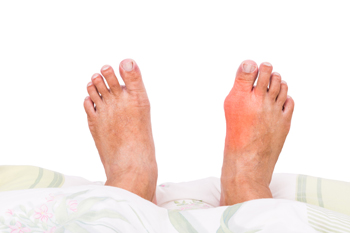Foot Problems That Mimic Bunions
Tuesday, 16 May 2023 00:00
People with a big toe joint problem often assume it is from a bunion. However, other things can look like a bunion but are entirely different. Bunions are bony bumps that form on the sides of big toes. They result from a misalignment of the big toe joint and are not bone growths. Arthritis affecting the big toe joint can look like a bunion because a bone spur can develop on the joint. The skin on the bone spur can be inflamed and red, resembling a bunion. These bone spurs often occur on the top of the big toe joint rather than on the side of the joint. A ganglion cyst is a firm, fluid-filled sac that can occur on the big toe joint and be mistaken for a bunion, but is softer to the touch. Gout is yet another affliction that can affect the big toe joint and cause symptoms of redness and swelling, looking like a bunion. If you notice something different about your big toe joint and wonder if it is a bunion, it is suggested that you visit a podiatrist to get a proper diagnosis and treatment.
If you are suffering from bunion pain, contact one of our podiatrists of Piedmont Podiatry Associates. Our doctors can provide the care you need to keep you pain-free and on your feet.
What Is a Bunion?
Bunions are painful bony bumps that usually develop on the inside of the foot at the joint of the big toe. As the deformity increases over time, it may become painful to walk and wear shoes. Women are more likely to exacerbate existing bunions since they often wear tight, narrow shoes that shift their toes together. Bunion pain can be relieved by wearing wider shoes with enough room for the toes.
Causes
- Genetics – some people inherit feet that are more prone to bunion development
- Inflammatory Conditions - rheumatoid arthritis and polio may cause bunion development
Symptoms
- Redness and inflammation
- Pain and tenderness
- Callus or corns on the bump
- Restricted motion in the big toe
In order to diagnose your bunion, your podiatrist may ask about your medical history, symptoms, and general health. Your doctor might also order an x-ray to take a closer look at your feet. Nonsurgical treatment options include orthotics, padding, icing, changes in footwear, and medication. If nonsurgical treatments don’t alleviate your bunion pain, surgery may be necessary.
If you have any questions, please feel free to contact one of our offices located in Greenville, and Easley, SC . We offer the newest diagnostic and treatment technologies for all your foot care needs.




